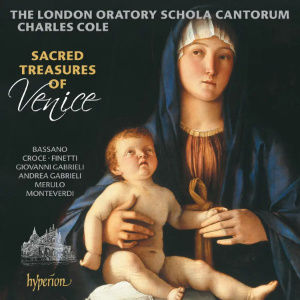
Sacred Treasures of Venice
The London Oratory Schola Cantorum/Charles Cole
rec. 2023, St. Augustine’s Church, Kilburn, London
Hyperion CDA68427 [66]
The photograph in the booklet shows the choir of forty or so boys who sing on the sanctuary steps of St. Mark’s in Venice, and another view in front of Pala d’Oro, the ornate altarpiece at the Basilica. Director Charles Cole says in the opening remarks to his excellent notes that the average age of the choir is fourteen; the basses and tenors would be seventeen or so.
What a thrill it must have been for them to be there, and to sing wonderful sacred works by, amongst others, the three Giovannis – Gabrieli, Croce and Bassano. It is apparently quite a thrill even in the acoustic of St. Augustine’s in Kilburn. The notes say that the music on this recording has been ‘drawn from the liturgical repertoire that we sing in the London Oratory’.
Many pieces here are for divided choir, for example eight parts in Gabrieli’s Beata es virgo Maria,and in Croce’s even more impressive In spiritu humilitatis. There is much variety. When Bassano’s Dic nobis Maria began, it sounded to me more like a canzonet by Gastoldi or Morley. The following expressive motet Adoramus te Domine by Merulo requires long phrases and good breath control. The choir manages superbly, and the tuning – which can be problem at the end of phrases or sections – is never in doubt. The boys seem to have this music in their DNA, and Cole’s direction is faultless. I only felt that the choir may have been a little unwieldy in the rather laboured performance of Monteverdi’s Cantate Domino. It was probably written for a group of two to a part, if I read the booklet notes correctly.
You may want to invest in this disc also because of the less well-known pieces on the programme, such as the wonderfully expressive motet O crux ave, spes unica by the mysterious Giacomo Finetti. If you visit the Basilica di Santa Maria Gloriosa dei Frari, the largest church in Venice, there is the slab of Monteverdi’s grave behind one of the screens. Finetti directed a choir at the Frari.
Andrea Gabrieli, easily overlooked in favour of his nephew, is represented by two fine works. Especially moving are the final cascading Alleluias in the Easter Day motet Maria Magdalene, Maria Jacobi et Salome.
Giovanni Croce was a priest at the great late-renaissance church of Santa Maria Formosa but sang at St. Mark’s, where he was later the full-time musical director. It may have been for the choir of Santa Maria that he composed these less demanding, more homophonic, four-part motets. Consider the highly expressive rare setting of In spiritu humilitatis, words the priest normally only speaks during mass. It may have been Croce’s reputation for striking madrigals that attracted Dowland to visit him, not Gabrieli, in 1595.
I recommend this disc for the wonderful performances by a talented and well-trained choir, and for the repertoire. The recording also does the whole project justice.
Gary Higginson
If you purchase this recording using a link below, it generates revenue for MWI and helps us maintain free access to the site


Contents
Giovanni Gabrieli (c.1555-1612)
Jubilate Deo omnis terra
Beata es virgo Maria
Ego sum qui sum
O quam suavis
Giovanni Bassano (c.1560-1617)
Dic nobis Maria
Claudio Merulo (1533-1604)
Adoramus te Domine
Beata viscera
Claudio Monteverdi (1567-1643)
Adoramus te ChristeCantate Domino
Giacomo Finetti (fl.c105-1631)
O crux ave, spes unica
Andrea Gabrieli (c.1510-1586)
Laetare Jerusalem
Maria Magdalene, MariaJacobi, et Salome
Giovanni Croce (c.1557-1609)
Cantate Domino
O sacrum convivium
In spiritu humilitatis
Buccinate in neomenia

















